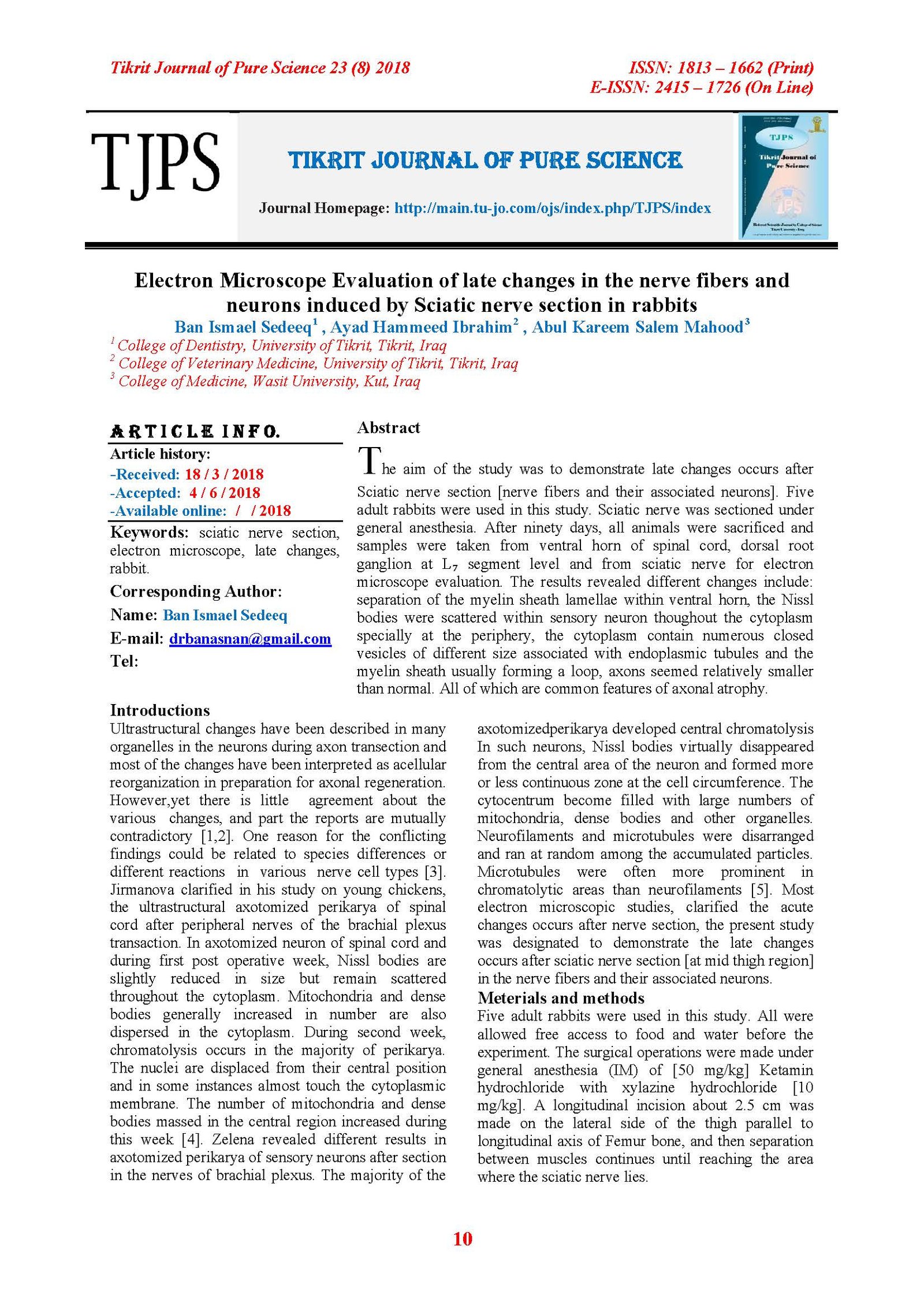Electron Microscope Evaluation of late changes in the nerve fibers and neurons induced by Sciatic nerve section in rabbits
Main Article Content
Abstract
The aim of the study was to demonstrate late changes occurs after Sciatic nerve section [nerve fibers and their associated neurons]. Five adult rabbits were used in this study. Sciatic nerve was sectioned under general anesthesia. After ninety days, all animals were sacrificed and samples were taken from ventral horn of spinal cord, dorsal root ganglion at L₇ segment level and from sciatic nerve for electron microscope evaluation. The results revealed different changes include: separation of the myelin sheath lamellae within ventral horn, the Nissl bodies were scattered within sensory neuron thoughout the cytoplasm specially at the periphery, the cytoplasm contain numerous closed vesicles of different size associated with endoplasmic tubules and the myelin sheath usually forming a loop, axons seemed relatively smaller than normal. All of which are common features of axonal atrophy
Article Details

This work is licensed under a Creative Commons Attribution 4.0 International License.
Tikrit Journal of Pure Science is licensed under the Creative Commons Attribution 4.0 International License, which allows users to copy, create extracts, abstracts, and new works from the article, alter and revise the article, and make commercial use of the article (including reuse and/or resale of the article by commercial entities), provided the user gives appropriate credit (with a link to the formal publication through the relevant DOI), provides a link to the license, indicates if changes were made, and the licensor is not represented as endorsing the use made of the work. The authors hold the copyright for their published work on the Tikrit J. Pure Sci. website, while Tikrit J. Pure Sci. is responsible for appreciate citation of their work, which is released under CC-BY-4.0, enabling the unrestricted use, distribution, and reproduction of an article in any medium, provided that the original work is properly cited.
References
[1] Evans DHL and Gray EG.(1961). Changes in the fine structure of ganglion cells during chromatolysis, In: Cytology of nervous tissue, Proc. Anat. Soc. Gr. Britanian and Ireland. London: Taylor and Francis Ltd; P. 71-74.
[2] Hudson G, Lazaro A, Hartman JF. (1961). A quantitative electron microscopic study of mitochondria in motor neurons following axonal section. Exp, Cell Res. ;(24):440-56.
[3] Torvik A, Skjӧrten F. (1971). Electron microscopic observations on nerve cell regeneration and degeneration after axon lesions, Acta neuropath (17): 248-64.
[4] Jirmanova I. (1971). Glycogen deposits in Motoneurons of young chickes following peripheral nerve section. Acta neuropath ;19:110-20.
[5] Zelena J. (1971). Neurofilaments and microtubules in sensory neurons after peripheral nerve section. Cell and tissue Research ;117(2):191-211.
[6] Krinke, FE.; Heumann, M.; Schnider, K., Da Silva, F. and Suter J. (1988). Adjustment of the myelin sheath to axonal atrophy in the rat spinal root by the formation of infolded myelin loops. Acta Anatomica; 131: 182-7.
[7] Kerezoudi, E.; King, RH., Muddle, JR.; O'Neill, JA. And Thomas, PK. (1995). Influence of age on the late retrograde effects of sciatic nerve section in the rat. J. Anat.;187(Pt 1):27– 35.
[8] Ceballos, D.; Cuadras, J.; Verdu, E. and Navarro X. (1993). Morphometric and ultrastructural changes with aging in mouse peripheral nerve. J. Anat.; 195:563-76.
[9] Muma, NA. and Hoffman, PN. (1993). Neurofilaments are intrinsic determinants of axonal caliber. Micron; 24:677-83.
[10] Verdu E, Ceballos D, Vilches J, Navarro X. Influence of aging on peripheral nerve function and regeneration.J Peripher NervSyst 2000; 2(4):191-208.
[11] Tiraihi, T. and Rezaie, MJ. (2003). Apoptosis onset and box protein distribution in spinal motoneurons of newborn rats following sciatic nerve axotomy. Interna J. Neurosci. ;113(9):1163-75.
[12] Edmund, BM. and, Mary, BB. (1967). Cytological studies of organotypic culture of rat dorsal root ganglia follinf X- Irradiation in vitro. J. Cell Biol. 1967;32: 467-95.
[13] Johnson, IP. and Sears, TA. (2013). Target-dependence of sensory neurons: an ultrastructural comparison of axotomised dorsal root ganglion neurons with allowed or denied reinnervation of peripheral targets. Neuroscience. 228:163-78.
[14] Saggu, SK.; Chotaliya, HP.; Blumbergs, PC. And Casson, RJ. (2010). Wallerian-like axonal degeneration in the optic nerve after excitotoxic retinal insult: an ultrastructural study. BMC Neuroscience;11:97.
[15] Burnett, MG. and Zager, EL. (2014). Pathophysiology of Peripheral Nerve Injury: A Brief Review. Neurosurg Focus.;16(5):1-7.
